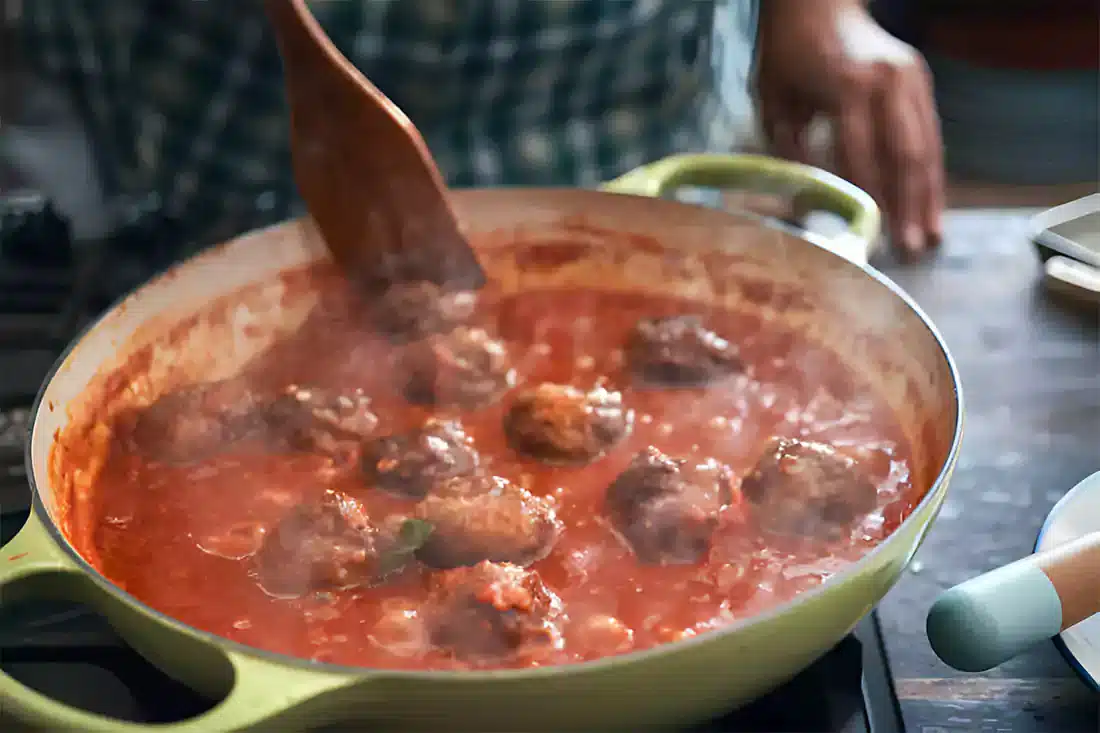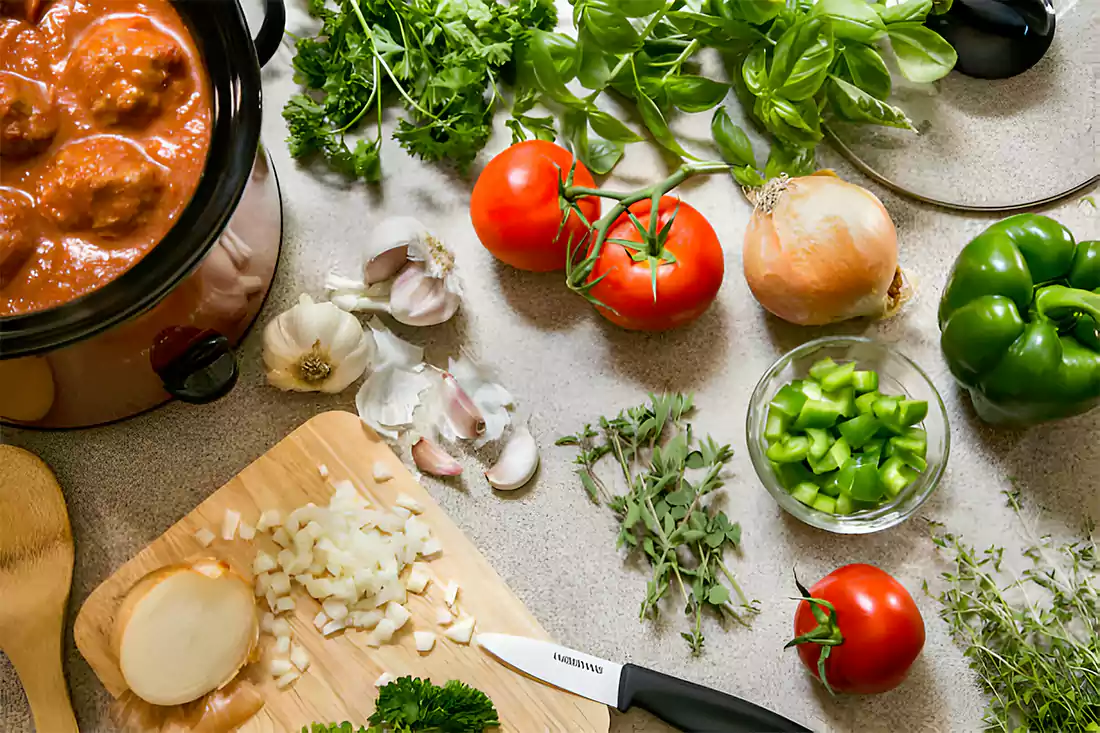Introduction to Porcupine Meatballs with Tomato Soup
Ah, the allure of porcupine meatballs with tomato soup—just the name alone sparks intrigue, doesn’t it? Prepare yourself, for we’re about to dive into a culinary expedition, tracing back to the origins of this timeless dish. Imagine a bygone era where kitchen simplicity and ingenuity were paramount. It’s in this setting that porcupine meatballs with tomato soup emerged, a brilliant creation of resourceful home cooks from yesteryears.
Discovering Porcupine Meatballs with Tomato Soup: A Culinary Journey
In times of scarcity, creative chefs ingeniously mixed ground beef with rice, extending their limited supplies—a true testament to culinary resourcefulness. As these meatballs simmered, the rice grains would expand, mimicking a porcupine’s quills, thus inspiring the unique name. Yet, it wasn’t merely their distinctive look that endeared porcupine meatballs with tomato soup to many; their satisfying richness, cost-effectiveness, and straightforward preparation solidified their status as a beloved staple.
The Fascinating Tale Behind Porcupine Meatballs with Tomato Soup
Porcupine meatballs with tomato soup stand out as a culinary wonder. Their signature look, characterized by rice grains that extend outward post-cooking, lends an intriguing texture and bite. Bathed in a rich tomato soup, these meatballs soak up a symphony of tangy and savory notes, ensuring each mouthful is a celebration. This dish isn’t just a feast for the eyes but a delight for the palate, and we’re on the brink of delving into its components and method, empowering you to bring this historical delicacy to life in your kitchen. Anticipate a delectable journey through history!
Essential Ingredients for Crafting Porcupine Meatballs with Tomato Soup
Embarking on the culinary adventure of making porcupine meatballs with tomato soup begins with gathering the right ingredients. This dish, celebrated for its simplicity and heartiness, calls for items that are likely already in your pantry or easily found at your local grocery store.
Ingredients List
To whip up this comforting meal, you’ll need:
- Ground beef: The cornerstone of our meatballs, providing richness and depth.
- White rice: Uncooked, to mix into the meatballs, giving them their signature “porcupine” texture.
- Onion: Finely chopped, to infuse the meatballs with a subtle sweetness and aroma.
- Garlic: Minced, for that essential punch of flavor.
- Tomato soup: The base for our luscious sauce, enveloping the meatballs in a tangy, creamy embrace.
- Worcestershire sauce: Just a dash, to add complexity and a hint of umami.
- Salt and pepper: To taste, ensuring our meatballs are seasoned to perfection.
- Herbs and spices: Think parsley, oregano, or basil, to add a layer of freshness and fragrance.
For those with dietary restrictions, fear not! Ground turkey can replace beef for a lighter version, and for a gluten-free twist, swap out traditional rice for a suitable alternative like quinoa or gluten-free rice.
The Step-by-Step Guide to Porcupine Meatballs with Tomato Soup
Now, let’s get down to business:
- Mixing the Magic: In a large bowl, combine the ground beef, uncooked rice, chopped onion, minced garlic, and your chosen herbs and spices. This is where the magic starts—mixing these ingredients by hand not only ensures everything is well incorporated but also connects you to the generations of cooks who’ve made this dish before.
- Forming the Meatballs: Once your mixture is ready, it’s time to shape those meatballs. Aim for a size that’s just right—not too big, so they cook through evenly, and not too small, so they don’t lose their juiciness. As you roll them between your palms, imagine the rice grains transforming into those quirky “quills” that give our dish its name.
- Simmering in Sauce: In a separate pot, bring the tomato soup to a gentle simmer, adding a touch of water or broth to achieve the desired consistency. Gently place the meatballs in the sauce, cover, and let them cook, allowing them to soak up the flavors and become tender and succulent.
- The Final Touch: Once the meatballs are cooked through, give the sauce a final taste check, adjusting the seasoning if necessary. Then, serve hot, perhaps with a sprinkle of grated Parmesan or a garnish of fresh herbs, to add that extra flair.
There you have it—the steps to creating a dish that’s not just a meal but a warm hug on a plate. As we move forward, we’ll explore the various cooking techniques that can take your porcupine meatballs with tomato soup to the next level, ensuring every bite is a testament to your culinary prowess.
Perfecting Your Porcupine Meatballs with Tomato Soup: Techniques and Tips
Mastering the art of cooking porcupine meatballs with tomato soup involves more than just following a recipe; it’s about embracing the techniques that elevate this dish from good to unforgettable. Let’s delve into the methods that will ensure your meatballs are the talk of the table.
Cooking Methods
Here are three ways to prepare your porcupine meatballs:
- Oven-Baked: Achieve a firmer texture and a caramelized crust by baking at 375°F (190°C) for 45 minutes.
- Stovetop Simmering: The traditional method keeps meatballs tender and flavorful. Simmer in sauce for about an hour, stirring occasionally.
- Slow Cooker: Enjoy convenience and tenderness by slow-cooking for 4-6 hours.
Key Techniques for Best Results
To ensure your porcupine meatballs with tomato soup are nothing short of spectacular, keep these tips in mind:
- Don’t Overmix: When combining your meatball ingredients, mix until just combined. Overworking the meat can lead to tough meatballs, and we’re all about that tender, juicy bite.
- Uniform Size: Consistency is key when forming your meatballs. Not only does it ensure they cook evenly, but it also makes for a more visually appealing dish. A cookie scoop or a tablespoon can be handy tools to achieve uniformity.
- Gentle Simmering:Whether you’re cooking on the stovetop or in the slow cooker, a gentle simmer is crucial for melding flavors beautifully and ensuring the meatballs cook through without falling apart. It allows the flavors to meld beautifully and the meatballs to cook through without falling apart.
- Taste and Adjust: Don’t forget to taste your sauce before serving. Adjusting the seasoning at the end can make all the difference, ensuring your dish has just the right balance of flavors.
By mastering these techniques, you’re not just cooking; you’re creating a culinary experience that brings warmth, comfort, and a touch of nostalgia to every bite. As we move on to explore the best ways to serve and pair your porcupine meatballs with tomato soup, remember that cooking is an art, and with these techniques, you’re painting a masterpiece.
Ingredients for Porcupine Meatballs with Tomato Soup
- 1 pound ground beef
- 1/2 cup uncooked white rice
- 1/4 cup finely chopped onion
- 2 cloves garlic, minced
- 1 can (10.75 ounces) tomato soup
- 1 tablespoon Worcestershire sauce
- Salt and pepper to taste
- Optional herbs and spices: parsley, oregano, basil (1 teaspoon each, dried or fresh)
Directions
- Prep the Meatball Mixture:
- In a large mixing bowl, combine the ground beef, uncooked rice, chopped onion, minced garlic, and your choice of herbs and spices. Season with salt and pepper to taste.
- Mix the ingredients gently with your hands or a fork until just combined. Be careful not to overmix to avoid tough meatballs.
- Form the Meatballs:
- Take small portions of the mixture and roll them into balls, about 1 to 1.5 inches in diameter. Ensure each meatball is compact and uniform in size for even cooking.
- Prepare the Tomato Soup Sauce:
- In a separate pot, pour the can of tomato soup. Add a can of water (use the empty tomato soup can for measurement) to thin out the sauce slightly. Stir in the Worcestershire sauce and bring the mixture to a simmer over medium heat.
- Cook the Meatballs:
- Once the tomato soup sauce is simmering, gently place the meatballs into the pot, making sure they are covered by the sauce.
- Reduce the heat to low, cover the pot, and let the meatballs simmer for about 45 minutes to an hour. The meatballs should be cooked through, and the rice inside should be tender.
- Serve:
- Carefully remove the meatballs from the sauce and place them on a serving dish. Spoon the tomato soup sauce over the meatballs.
- Garnish with a sprinkle of grated Parmesan cheese and chopped parsley, if desired, for an extra touch of flavor and color.
- Enjoy:
- Serve your porcupine meatballs hot, accompanied by your choice of side dishes like mashed potatoes, steamed vegetables, or crusty bread to soak up the delicious sauce.
This classic recipe for porcupine meatballs with tomato soup is a comforting and hearty meal that’s perfect for any occasion. Feel free to tweak the ingredients and seasonings according to your taste preferences and dietary needs. Enjoy your cooking adventure!
Savoring the Flavors: Serving Porcupine Meatballs with Tomato Soup
After your porcupine meatballs with tomato soup are cooked to perfection, consider presentation and side dishes. These elements can elevate the dish to a gourmet experience.
Serving Suggestions
For perfect presentation of porcupine meatballs, follow these tips:
- Plating: Serve meatballs in a deep dish with a rich tomato sauce for a juicy, flavorful experience. Sprinkle freshly grated Parmesan cheese or chopped parsley for a burst of color and enhanced taste.
- Side Dishes: Complement the meatballs with balanced sides. Try a crisp green salad with a light vinaigrette, steamed green beans, or roasted vegetables for freshness and crunch. For heartier options, consider garlic mashed potatoes, creamy polenta, or crusty bread to soak up the delicious sauce.
Wine and Beverage Pairing
The right drink can elevate your meal, creating a harmonious dining experience:
- Wine: A medium-bodied red wine, such as a Merlot or a Chianti, can complement the richness of the meatballs without overpowering the dish, balancing the acidity of the tomato sauce beautifully. The fruity notes and soft tannins of these wines balance the acidity of the tomato sauce beautifully.
- Non-Alcoholic Options: For a non-alcoholic pairing, consider a sparkling water with a squeeze of lemon to cleanse the palate between bites, or a rich tomato juice cocktail spiced with a dash of Worcestershire sauce and a hint of horseradish for an extra kick.
Achieving a successful pairing relies on balance. Your drink should enhance, not overshadow, your meal’s flavors. Whether you choose wine or a non-alcoholic option, make the right choice to elevate your porcupine meatballs with tomato soup.
Next, we’ll explore the nutrition of this cherished dish, ensuring it pleases both your taste buds and your health. Stay tuned for tips on making your porcupine meatballs healthier without compromising taste.
Nutritional Insights into Porcupine Meatballs with Tomato Soup
Exploring the nutrition of porcupine meatballs in tomato soup unveils a nourishing and delicious dish. Discovering its health benefits and possible tweaks can help you enjoy this comfort food while staying in line with your dietary needs and goals.
Health Benefits
At its core, this dish combines protein-rich ground beef, energy-giving rice, and the antioxidant properties of tomatoes, making it a well-rounded meal:
- Protein: The ground beef in the meatballs is a great source of high-quality protein, essential for muscle repair and growth.
- Carbohydrates: Rice, the signature ingredient that gives these meatballs their “porcupine” effect, provides carbohydrates for energy, making this dish satisfying and filling.
- Vitamins and Minerals: The tomato soup, rich in vitamins C and K, potassium, and folate, contributes to the nutritional value of the dish, supporting heart health and boosting immunity.
Making the Dish Healthier
To make this recipe healthier without sacrificing taste:
- Choose Leaner Meat: Opt for lean ground beef or mix it with ground turkey for a meaty texture with less fat.
- Use Whole Grains: Replace white rice with brown rice or quinoa for added fiber and nutrients.
- Reduce Sodium: Pick low-sodium tomato soup or make your tomato sauce from scratch to control salt.
Additionally, porcupine meatballs with tomato soup can be a hearty, wholesome meal. Furthermore, we’ll explore customization options ahead to suit your taste and dietary needs, ultimately making it a beloved part of your repertoire. For more nutritional details, check USDA Nutritional Database.
Creative Twists on Classic Porcupine Meatballs with Tomato Soup
The beauty of porcupine meatballs with tomato soup lies in its versatility. Whether you’re catering to dietary restrictions, looking to spice things up, or simply using what you have on hand, there are countless ways to tweak this classic recipe while maintaining its comforting essence.
Recipe Variations
Let’s explore some creative twists to keep this dish exciting:
- Vegetarian and Vegan Options: For a meat-free version, consider using lentils or a meat substitute in place of ground beef, adding your own personal touches to suit your dietary needs. You can also experiment with different types of rice or grains to vary the texture and nutritional profile.
- Gluten-Free Adaptations: To make this dish gluten-free, ensure that your rice and tomato soup are free from gluten-containing ingredients. Many stores offer gluten-free alternatives that are perfect for this recipe.
- Spicing It Up: If you’re looking to add a bit of heat, consider incorporating spices like chili powder, cumin, or paprika into the meatball mix. A dash of red pepper flakes in the tomato sauce can also elevate the dish with a warm, spicy kick.
- Adding Veggies: Sneak in some extra nutrients by adding finely chopped vegetables such as carrots, zucchini, or bell peppers to the meatball mixture. Not only does this boost the health factor, but it also adds color and variety to the dish.
Cultural Twists
Taking inspiration from various cuisines can lead to delightful variations of the classic porcupine meatball recipe:
- Italian-Inspired: Incorporate Italian herbs like oregano and basil into the meatballs and use a marinara sauce in place of tomato soup for a Mediterranean twist.
- Asian Fusion: For an Asian flair, add ingredients like ginger, soy sauce, and green onions to the meatball mix, and serve with a side of steamed rice or noodles.
- Middle Eastern Version: Mix in spices like cumin, coriander, and a hint of cinnamon into the meatballs, and serve with a tangy yogurt sauce for a Middle Eastern touch.
Various porcupine meatball variations cater to diverse diets and preferences, making this dish a creative culinary canvas. Additionally, in the next section, we’ll answer common questions to help you master this recipe in your kitchen.
Your Questions Answered: Porcupine Meatballs with Tomato Soup FAQs
As we explore the world of porcupine meatballs with tomato soup, we’ve covered basics and creative twists. Now, let’s answer common questions to boost your confidence in bringing this dish to life.
Frequently Asked Questions
- Can I make porcupine meatballs ahead of time? Absolutely! These meatballs freeze beautifully. Simply prepare and cook them as directed, allow them to cool, and then freeze them in an airtight container for future enjoyment. When you’re ready to enjoy them, thaw in the refrigerator and reheat gently on the stove or in the oven.
- How can I ensure my meatballs don’t fall apart while cooking? The key is in the binding ingredients. Ensure your mixture has enough egg and that the rice is evenly distributed throughout the meat. Be gentle when forming the meatballs and avoid overcooking, which can cause them to dry out and crumble.
- What’s the best way to reheat leftovers? Gently reheat leftovers on the stove over low heat, adding a splash of water or broth if the sauce has thickened too much in the fridge. This method helps maintain the moisture and flavor of the meatballs.
- Can I use brown rice instead of white rice? Yes, you can use brown rice, but keep in mind it has a longer cooking time and might result in firmer meatballs. Consider partially cooking the brown rice before adding it to the meat mixture to ensure it’s fully cooked in the final dish.
- Is it possible to make the tomato soup sauce from scratch? Definitely! If you prefer to make your sauce, simply simmer a blend of crushed tomatoes, garlic, onion, and your favorite herbs and spices until it thickens to your liking. This allows for more control over the ingredients and flavor profile.
In addressing your questions, we aim to remove obstacles in making tasty porcupine meatballs with tomato soup. Stick to tradition or get creative, this dish guarantees satisfaction.
As we wrap up our guide, remember that cooking is about personalizing recipes. Put on your apron, cook up those meatballs, and create cherished memories in your kitchen.



